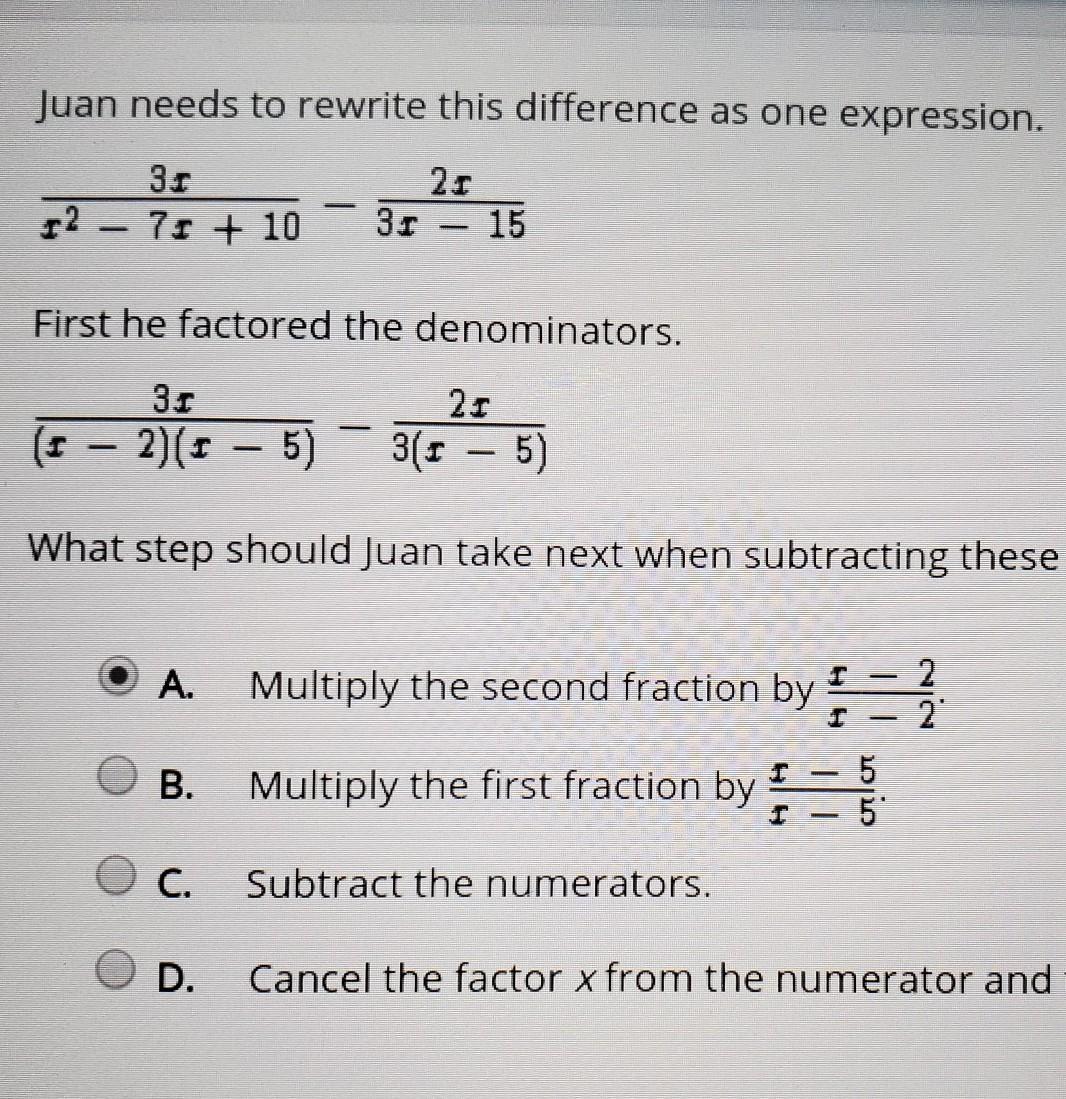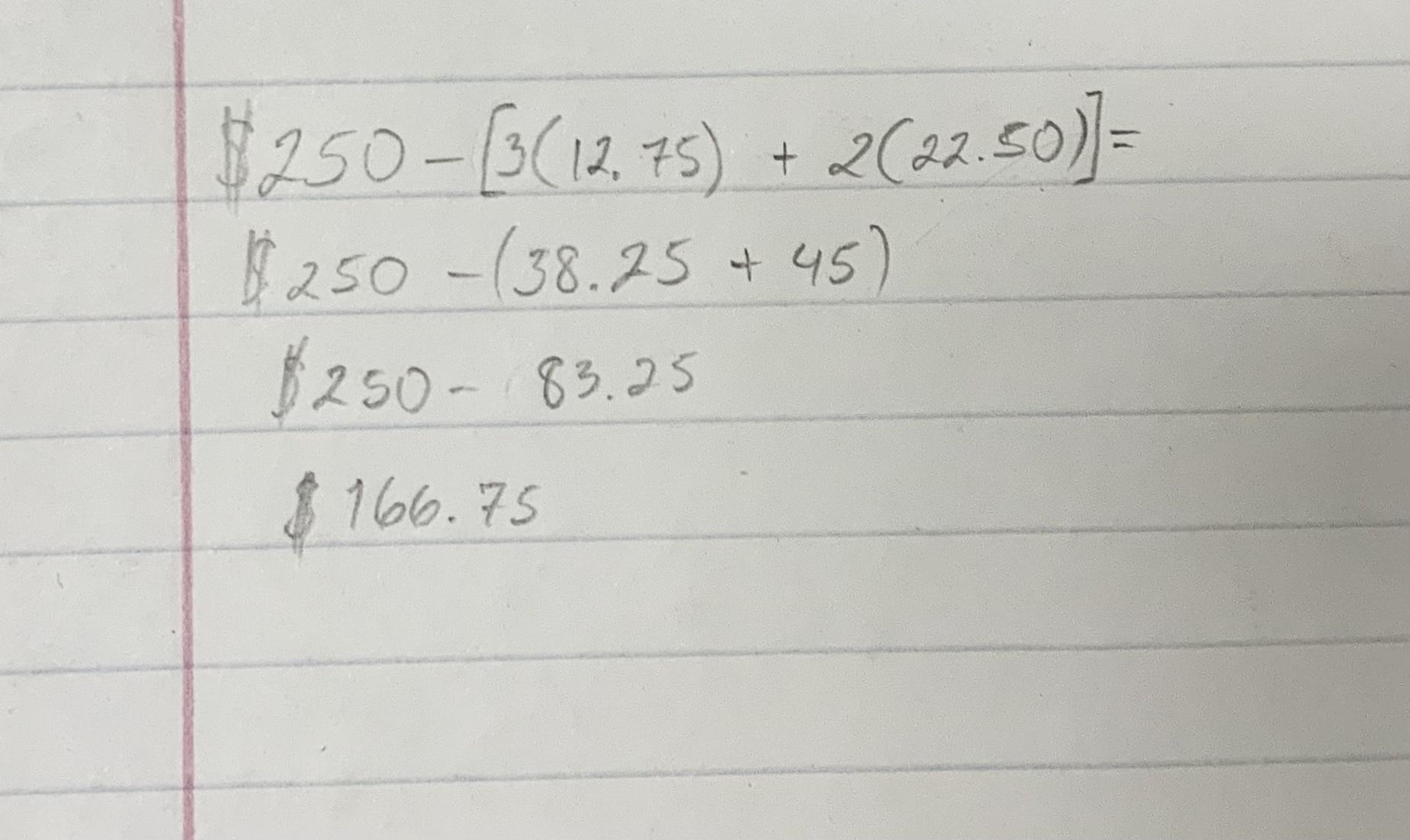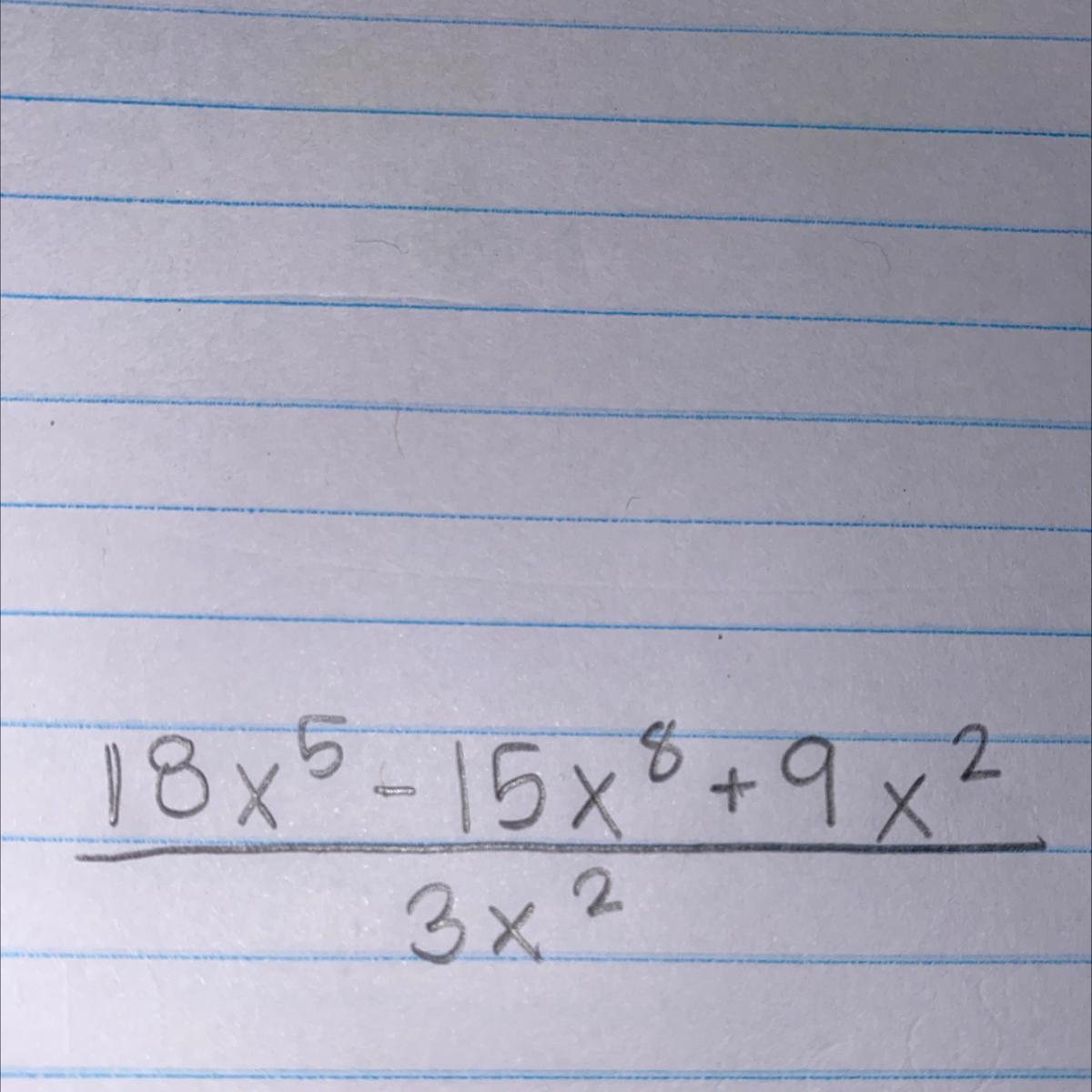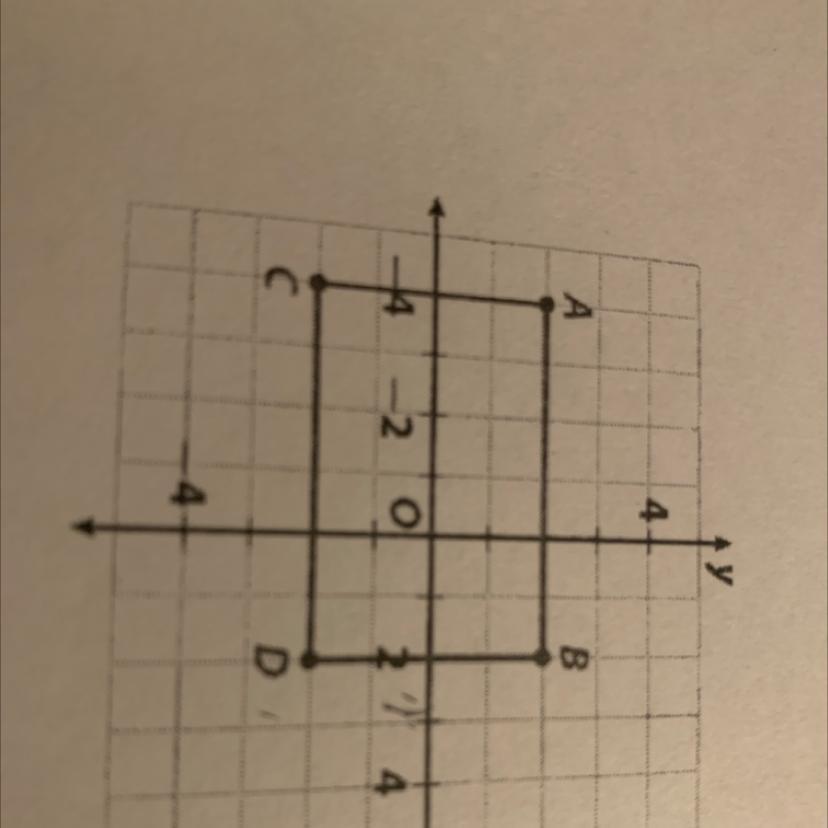HELP SUMMER ALGEBRA 2! the rest of the answer d is numerator and denominator of both fractions

Answers
9514 1404 393
Answer:
the correct choice is marked
Step-by-step explanation:
The denominators of the two fractions must be the same. To make that happen, Juan can multiply the second fraction by (x-2)/(x-2) -- the marked answer choice -- and multiply the first fraction by 3/3. These operations can be done in some order.
The offered choices suggest that treating the second fraction first is Juan's preferred choice.
multiply the second fraction by (x-2)/(x-2)Related Questions
If x=2y+5 and x=3y-6, what is the value of x?
Answers
Explanation:
From the second equation, you know that x = 5 - 2y
Substitute this expression for ∞ in the first equation to get
2(5 - 2y) + 3y = 6
10-4y +34 = 6
-y = - 4
y =4
Now that we have found y, we can find * using
X=5-24 -> X =5-2.4 = -3
The diagram shows a triangle.
31° / 6x / x+16°
What is the value of x?
Answers
Step-by-step explanation:
31 + 6x + x + 16 = 180
7x + 47 = 180
7x = 180 - 47
x = 133/7
x = 19
Real estate ads suggest that 62% of homes for sale have garages 28% have swimming pools and 18% have both features. If a home for sale has a garage what’s the probability that it has a pool too?
Answers
Answer:
Step-by-step explanation:
The events are not independentd) The events are not mutually exclusiveStep-by-step explanation:Hi!Lets call: Gar = {homes with garage}Pool
A real estate broker decides to lease a car for 36 months. Suppose the anual interest rate is 7.8%, the negotiated price is $49,000, there is no trade-in, and the down payment is $4,000. Find the monthly lease payment (in dollars). Assume that the residual value is 49% of the MSRP of $51,500. (Round your answer to the nearest cent.)
Answers
To calculate the monthly lease payment, we need to use the formula:
Monthly Payment = Depreciation + Finance Charge
The depreciation represents the portion of the car's value that is lost during the lease period, while the finance charge is the interest charged on the lease.
First, let's calculate the depreciation:
MSRP = $51,500
Residual Value = 49% of MSRP = 0.49 x $51,500 = $25,235
Depreciation = (Negotiated Price - Residual Value - Down Payment) / Lease Term
Depreciation = ($49,000 - $25,235 - $4,000) / 36 = $541.53
Next, let's calculate the finance charge:
Lease Balance = (Negotiated Price - Down Payment) - Residual Value
Lease Balance = ($49,000 - $4,000) - $25,235 = $19,765
Money Factor = Annual Interest Rate / 2400
Money Factor = 7.8% / 2400 = 0.00325
Finance Charge = Lease Balance x Money Factor
Finance Charge = $19,765 x 0.00325 = $64.26
Finally, we can calculate the monthly payment:
Monthly Payment = Depreciation + Finance Charge
Monthly Payment = $541.53 + $64.26 = $605.79
Therefore, the monthly lease payment is $605.79.
find the missing angle

Answers
Answer:
? = 77°
Step-by-step explanation:
the 3 angles in a triangle sum to 180° , that is
? + 35° + 68° = 180°
? + 103° = 180° ( subtract 103° from both sides )
? = 77°
Answer:77
Step-by-step explanation:
180-103=77
what is the solution to the equation:
5(n - 1/10) = 1/2
a. n= 13/5
b. n= 3/25
c. n= 0
d. n= 1/5
Answers
\( \sf \longrightarrow \: 5 \bigg( \: n - \frac{1}{10} \bigg) = \frac{1}{2} \\ \)
\( \sf \longrightarrow \: 5 \bigg( \: \frac{n}{1} - \frac{1}{10} \bigg) = \frac{1}{2} \\ \)
\( \sf \longrightarrow \: 5 \bigg( \: \frac{10 \times n - 1 \times 1}{1 \times 10} \bigg) = \frac{1}{2} \\ \)
\( \sf \longrightarrow \: 5 \bigg( \: \frac{10n - 1}{ 10} \bigg) = \frac{1}{2} \\ \)
\( \sf \longrightarrow \: \: \frac{50n - 5}{ 10} = \frac{1}{2} \\ \)
\( \sf \longrightarrow \: \: 2(50n - 5) =1(10) \\ \)
\( \sf \longrightarrow \: \: 2(50n - 5) =10 \\ \)
\( \sf \longrightarrow \: \: 100n - 10=10 \\ \)
\( \sf \longrightarrow \: \: 100n =10 + 10\\ \)
\( \sf \longrightarrow \: \: 100n =20\\ \)
\( \sf \longrightarrow \: \:n = \frac{2 \cancel{0}}{10 \cancel{0}} \\ \)
\( \sf \longrightarrow \: \:n = \frac{1}{5} \\ \)
Answer:-
Answer:- D) n = ⅕ ✅To solve the equation \(\sf 5(n - \frac{1}{10}) = \frac{1}{2} \\\) for \(\sf n \\\), we can follow these steps:
Step 1: Distribute the 5 on the left side:
\(\sf 5n - \frac{1}{2} = \frac{1}{2} \\\)
Step 2: Add \(\sf \frac{1}{2} \\\) to both sides of the equation:
\(\sf 5n = \frac{1}{2} + \frac{1}{2} \\\)
\(\sf 5n = 1 \\\)
Step 3: Divide both sides of the equation by 5 to isolate \(\sf n \\\):
\(\sf \frac{5n}{5} = \frac{1}{5} \\\)
\(\sf n = \frac{1}{5} \\\)
Therefore, the solution to the equation \(\sf 5(n - \frac{1}{10})\ = \frac{1}{2} \\\) is \(\sf n = \frac{1}{5} \\\), which corresponds to option (d).
\(\huge{\mathfrak{\colorbox{black}{\textcolor{lime}{I\:hope\:this\:helps\:!\:\:}}}}\)
♥️ \(\large{\underline{\textcolor{red}{\mathcal{SUMIT\:\:ROY\:\:(:\:\:}}}}\)
Luna started off with $250 in her bank account she bought 3 x-box games that cost 12.75 each and 2 playstation games that cost 22.50 each how much money left in her bank account. Can some help me please
Answers
Answer:
$166.75
Step-by-step explanation:
look at the photo.
Hope this helps. Please mark me brainliest!

what is this please help

Answers
Answer:
the 2nd option is correct.
Step-by-step explanation:
Hope you have a great day!
If it helped mark me as brainliest!
Answer:
It is B
Step-by-step explanation:
All it is asking is what times itself equals 64, 8*8 equals 64 and -8*-8 equals 64 so therefore it is line B, if you want to learn this better by yourself just look at the numbers and ignore the letters, it makes it less scary. Please mark brainlest.
Which sets of ordered pairs represent functions from A to B? (Select all that apply.) A = {a, b, c} and B = {3, 4, 5, 6}
Answers
Answer:
See Explanation
Step-by-step explanation:
The question has mission options; However, the question is still solvable.
Given
\(A = \{a,b,c\}\)
\(B = \{3,4,5,6\}\)
Required
Determine possible ordered pairs of A to B
A function is of the form (x,y)
Let A be the range of the function and B, the domain
Let (x,y) be a function of A to B, where x represents any of the values in A sets and y represents any of the values in B
A ordered pair can only be regarded as a function if and only if it has unique y-values
Hence, a possible ordered pair is:
\((A,B) = \{(a,3),(b,4),(c,5)\}\)
Another possible ordered pair is
\((A,B) = \{(a,4),(b,5),(c,6)\}\)
Note that there as as many as possible ordered pair as long as the y-values are unique
There are many possible ordered pair as long as the y-values are unique.
A function is defined as a relation from a set of inputs to a set of possible outputs where each input is related to exactly one output.A functions from A to B represent A as domain and B as range of function.Given that, A = {a, b, c} and B = {3, 4, 5, 6}
Order pair may be,
\((a,3),(b,4),(c,5)\)
May be, \((a,6),(b,5),(c,4)\)
There are many possible ordered pair as long as the y-values are unique.
Learn more:
https://brainly.com/question/13856645
Show that the angle bisector of an equilateral triangle is perpendicular to the base
Answers
To show that the angle bisector of an equilateral triangle is perpendicular to the base, we can assume an equilateral triangle with sides ABC. Next, we can get an angle bisector in the middle represented by BD which becomes perpendicular to the base BC.
How to prove that the angle bisector is perpendicular to baseAfter getting the angle bisector, we would see that the line segment BD, divides angle BAC into two equal angles, each measuring 30 degrees. Now, we can draw a perpendicular line from point D to the base BC.
We could also draw a line E, which is the perpendicular line that intersects the base BC. We want to show that BD is perpendicular to BC, which means we need to show that angle BDE is a right angle.
Since the sum of angles BDA and ADE is 90 degrees (they form a right angle), and the sum of angles BAD, ABD, and BDA is 180 degrees, it follows that angle BDE must be a right angle.
Therefore, we have shown that the angle bisector of an equilateral triangle is perpendicular to the base.
Learn more about the angle bisector of an equilateral triangle here:
https://brainly.com/question/30341397
#SPJ1
Question 6 of 10
What is the solution to the system of equations graphed below?
y = -2x + 4
y=x-5
Answers
Answer:
the solution to the system of equations is (x, y) = (3, -2).
Step-by-step explanation:
y = -2x + 4 (Equation 1)
y = x - 5 (Equation 2)
To solve for x, we can equate the right sides of the equations:
-2x + 4 = x - 5
Now, we can solve for x:
-2x - x = -5 - 4
-3x = -9
x = (-9) / (-3)
x = 3
Substituting the value of x back into Equation 2, we can solve for y:
y = 3 - 5
y = -2
SThe sixth term of an arithmetic sequence is35and the twelfth term is2What is the common difference of the arithmeticsequence?The common difference isDONE

Answers
Given:
The sixth term of an arithmetic sequence is
\(a_6=\frac{3}{2}\)The twelfth term is
\(a_{20}=\frac{5}{2}\)To find:
The common difference
Explanation:
The nth term formula of an arithmetic sequence is,
\(a_n=a+(n-1)d\)So, the sixth and twelfth terms become,
\(\begin{gathered} a_6=a+(6-1)d \\ \frac{3}{2}=a+5d..............(1) \\ a_{20}=a+(12-1)d \\ \frac{5}{2}=a+11d.............(2) \end{gathered}\)Subtract (1) from (2),
\(\begin{gathered} \frac{5}{2}-\frac{3}{2}=11d-5d \\ \frac{2}{2}=6d \\ 6d=1 \\ d=\frac{1}{6} \end{gathered}\)Thus, the common difference is,
\(d=\frac{1}{6}\)Final answer:
The common difference is,
\(d=\frac{1}{6}\)Allentown, Bakersfield, and Cowville are not in a line. If it is 57 miles in aline from Allentown to Bakersfield and 35 miles from Bakersfield to Cowville , how far is it from Allentown to Cowville?
Answers
Answer:
27
Step-by-step explanation:
322415154551
Answer:
92Step-by-step explanation:
Just simply add 57 to 35.
57+35=92
Kent earns $12.75 per hour at his part time job. Kent worked 18 hours last week. This week he spent 1/3 of his money on car repairs. How much did the repairs cost?
Answers
ANSWERS TO THE WHOLE QUIZ:
1. 13.23
2. 1/2
3. 0.25
4. 31.16
5. 76.50
Your Welcome and have a great day!
( I had to fail the quiz to give the answers)
Divide and simplify 9/7 + 9/2
Answers
Answer:
5.78571428571
Step-by-step explanation:
9/7 = 1.28571428571
9/2 = 4.5
And if you add it you get 5.78571428571
hopes this helps..
A) Find an equation for the line perpendicular to the tangent line to the curve y=x^3-4x+6 at the point (2,6)
-The equation is y=
b) What is the smallest slope on the curve? At what point on the curve does the curve have this slope?
-The smallest slope on the curve is
-The curve has the smallest slope at the point
c) Find equations for the tangent lines to the curve at the points where the slope of the curve is 8.
Answers
Answer:
f(x) = x³ - 4x + 6
f'(x) = 3x² - 4
a) f'(2) = 3(2²) - 4 = 12 - 4 = 8
6 = 8(2) + b
6 = 16 + b
b = -10
y = 8x - 10
b) 3x² - 4 = 0
3x² = 4, so x = ±2/√3 = ±(2/3)√3
= ±1.1547
f(-(2/3)√3) = 9.0792
f((2/3)√3) = 2.9208
c) 3x² - 4 = 8
3x² = 12
x² = 4, so x = ±2
f(-2) = (-2)³ - 4(-2) + 6 = -8 + 8 + 6 = 6
6 = -2(8) + b
6 = -16 + b
b = 22
y = 8x + 22
f(2) = 6
y = 8x - 10
The equation perpendicular to the tangent is y = -1/8x + 25/4
-The smallest slope on the curve is 2.92
The curve has the smallest slope at the point (1.15, 2.92)
The equations at tangent points are y = 8x + 16 and y = 8x - 16
Finding the equation perpendicular to the tangentFrom the question, we have the following parameters that can be used in our computation:
y = x³ - 4x + 6
Differentiate
So, we have
f'(x) = 3x² - 4
The point is (2, 6)
So, we have
f'(2) = 3(2)² - 4
f'(2) = 8
The slope of the perpendicular line is
Slope = -1/8
So, we have
y = -1/8(x - 2) + 6
y = -1/8x + 25/4
The smallest slope on the curveWe have
f'(x) = 3x² - 4
Set to 0
3x² - 4 = 0
Solve for x
x = √[4/3]
x = 1.15
So, we have
Smallest slope = (√[4/3])³ - 4(√[4/3]) + 6
Smallest slope = 2.92
So, the smallest slope is 2.92 at (1.15, 2.92)
The equation of the tangent lineHere, we set f'(x) to 8
3x² - 4 = 8
Solve for x
x = ±2
Calculate y at x = ±2
y = (-2)³ - 4(-2) + 6 = 6: (-2, 0)
y = (2)³ - 4(2) + 6 = 6: (2, 0)
The equations at these points are
y = 8x + 16
y = 8x - 16
Read more about tangent lines at
https://brainly.com/question/21595470
#SPJ1
help please! 50 points

Answers
Answer:
Use distributive property and divide each term as follows:
\((18x^5 - 15x^8 + 9x^2)/(3x^2) =\)\((18x^5)/(3x^2) - (15x^8)/(3x^2) + (9x^2)/(3x^2) =\)\(6x^3-5x^5+3 =\)\(-5x^5+6x^3+3\) bring to standard formFunctions for -4,-6,-9,-27/2,-81/2
Answers
The function of the sequence -4,-6,-9,-27/2,-81/2 is f(n) = -4(3/2)^(n - 1)
Identifying the function of the sequence
from the question, we have the following parameters that can be used in our computation:
-4,-6,-9,-27/2,-81/2
The above sequence is a geometric sequence
This is because it has a common ratio calculated as
r = -6/-4
So, we have
r = 3/2
The sequence is then represented as
f(n) = ar^n-1
So, we have
f(n) = -4(3/2)^(n - 1)
Hence, the function is f(n) = -4(3/2)^(n - 1)
Read more about sequence at
https://brainly.com/question/30499691
#SPJ1
The diameter of a quarter is 0.955 inches. If you laid 1,000,000 quarters side to
side, how far would that be?
Answers
950,000 inches
79,166.6666666 feet (1 foot=12 inches)
26,388.8888888 yards (1 yard=3 feet)
14.993686868 miles (1 mile=1760 yards)
Choose the correct answer below.
A. The numerator of the expression simplifies to for all x, so the limits are equal.
B. The limits and equal the same number when evaluated using direct substitution.
C. Since whenever x, it follows that the two expressions evaluate to the same number as x approaches .
D. Since each limit approaches , it follows that the limits are equal.
Answers
Answer:
B. The limits Lim x-->7 (x²-9x+14)/x-7 and lim x--> 7 (x-2) equals the same number when evaluated using direct substitution. The limit of both functions is 5
Step-by-step explanation:
Find the complete question in the attachment.
Given the limit of the functions
Lim x-->7 (x²-9x+14)/x-7
To solve this, we will need to factorize the quadratic function at the numerator first.
x²-9x+14
= x²-2x-7x+14
= x(x-2)-7(x-2)
= (x-7)(x-2)
The expression therefore becomes:
= lim x-->7 (x-7)(x-2)/x-7
= lim x-->7 (x-2)
Now substitute the value of x into the simplified function
lim x-->7 (x-2) = 7-2
lim x-->7 (x-2) = 5
Hence Lim x-->7 (x²-9x+14)/x-7 = 5
From the calculation above, it can be seen that Lim x-->7 (x²-9x+14)/x-7 = lim x--> 7 (x-2) = 5
Hence the correct answer based on the explanation above is B.
The limits Lim x-->7 (x²-9x+14)/x-7 and lim x--> 7 (x-2) equals the same number when evaluated using direct substitution.

What is the degree of 7 x6 - 6x5 + 2x3 + x-8?
O A. 6
O B. 7
O c. 5
O D. 8

Answers
Using the present value approach, solve the following:
Tom has $100 in a bank account that pays a guaranteed 5% interest rate each year. How much would Tom have at the end of Year 3?
Answers
Answer:
Step-by-step explanation:
$100x0.5x1=$5
I need expert answers for this

Answers
The last expression finally simplifies to cot β + tan α using quotient identity in trigonometric identities.
How to prove Trigonometric Identities?We want to verify the trigonometric identity;
cos (α - β)/(cos α sin β) = cot β + tan α
Now, according to trigonometric identities in mathematics, we know that;
cos (α - β) = (cos α cos β) + (sin α sin β)
Thus, plugging that back into our left hand side of the main question gives;
[(cos α cos β) + (sin α sin β)]/(cos α sin β)
Rewriting this expression by separating the denominator gives;
[(cos α cos β)/(cos α sin β)] + [(sin α sin β)]/(cos α sin β)
Using quotient identities, this can be simplified to;
cot β + tan α
Read more about Trigonometric Identities at; https://brainly.com/question/7331447
#SPJ1
What is the solution to the inequality 3/5 + y > or equal to 11/15
Answers
Answer:
y ≥ 2/15
HOPE THIS HELPS :)
Which decimal number is NOT between the two decimal numbers on the
number line?
6.
0.542
0.611
A
0.54
B
0.6
с
0.604

Answers
Answer:
A, .54
Step-by-step explanation:
The number line ranges from .542 up until .611, giving you three options below. For .6, it can be translated into .600 which is in bounds of the number line. Next for .604, it is still in bounds of the number line. For .54 it would be translated to .540 which is not in bounds, being before .542.
Find from first principle of derivative e^sinx ¡. e
Answers
Therefore, the derivative of e^(sin(x)) * \(e^{x}\) is \(e^{x}\) * \(e^{sinx}\)* (cos(x) + 1), which we have found from first principles using the product rule.
What are derivatives?In mathematics, a derivative is a measure of how a function changes as its input changes. It is the rate at which the function is changing at a particular point.
More specifically, the derivative of a function f(x) at a point x0 is defined as the limit of the difference quotient (f(x) - f(x0)) / (x - x0) as x approaches x0, provided this limit exists. This limit is denoted by f'(x0), which is read as "f prime of x0".
Geometrically, the derivative of a function at a point represents the slope of the tangent line to the graph of the function at that point.
The concept of derivatives is essential in calculus and is used in many fields of science, engineering, economics, and finance. They are used to find rates of change, optimize functions, and model physical phenomena.
We can use the product rule of differentiation to find the derivative of \(e^{sinx}\) * \(e^{x}\):
Let f(x) = \(e^{sinx}\) and g(x) = \(e^{x}\)then the product rule states that:
(f(x) * g(x))' = f(x)' * g(x) + f(x) * g(x)'
Now we find the derivatives of f(x) and g(x):
f(x) = \(e^{sinx}\), so, f'(x) = cos(x) * e^(sin(x))
g(x) =\(e^{x}\), so, g'(x) = \(e^{x}\)
Therefore, the derivative of \(e^{sinx}\) * \(e^{x}\)is:
(f(x) * g(x))' = \(e^{sinx}\) * \(e^{x}\))'
= f'(x) * g(x) + f(x) * g'(x)
= cos(x) * \(e^{sinx}\) * \(e^{x}\) + \(e^{sinx}\) * \(e^{x}\)
Simplifying this expression gives:
(\(e^{sinx}\)) * \(e^{x}\))' = \(e^{x}\) * \(e^{sinx}\)* (cos(x) + 1)
To learn more about function:
https://brainly.com/question/12431044
#SPJ1
Graph the image of rectangle ABCD after a dilation with a scale factor of 1/2 

Answers
Answer:
I took the time to graph the image onto the image that you had used, I hope this helps! <3
Step-by-step explanation:
Dilating by 1/2, is a contraction, it makes the pre-image smaller than the image.

if the system of linear equations above has no solutions and a is constant then what is the value of a
Answers
The value of x is 6.
What is system of linear equations?
A collection of one or more linear equations involving the same variables is known as a system of linear equations in mathematics. For instance, the system of three equations 3x + 2y - z = 1, 2x - 2y + 4z = -2, -x + y - z = 0 has the three variables x, y, and z.
A collection of one or more linear equations involving the same variables is known as a system of linear equations (or linear system) in mathematics.
Graphically, a system of linear equations that has no solution indicates two parallel lines-that is, two lines that have the same slope but different y-intercepts.
To have the same slope, the x-and y-coefficient must be the same.
To get from -2/3 to -8 you multiply by 12, so multiply -1/2x by 12 as well to yield 6x.
Because the other x-coefficient is a, it must be that a = 6 and (D) is correct.
Note that, even though it is more work, you could also write each equation in slope-intercept form and set the slopes equal to each other to solve for a.
Hence, the value of x is 6.
To know more about system of linear equations, click on the link
https://brainly.com/question/2226590
#SPJ4
HELP MEEEEEEEEEEEEEEEE PLSSSSSSSSSSSSSSSSSSSS I BEG I BEG

Answers
Answer:
A. There are 8 seventh grade students
B. There are 14 total questions on the test
Step-by-step explanation:
the graph of y equals negative x - 2 shown below use the graph to determine which of the ordered pairs is the solution to the equation

Answers
y = -x - 2
To check if an ordered pair is a solution to the equation, we have to replace the value of one variable and compute the other variable, as follows:
x = 1
y = -1 - 2
y = -3
Then, (1, -3) is a solution to the equation
x = -2
y = -(-2) - 2
y = 2 - 2
y = 0
Then, (-2, 0) is a solution to the equation
x = 4
y = -4 - 2
y = -6
Then, (4, -1) is not a solution to the equation
x = 0
y = -0 - 2
y = -2
Then, (0, 2) is not a solution to the equation, and (0, -2) is a solution to the equation